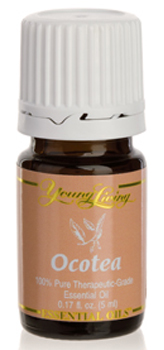The Power of Ecuador: Ocotea and Dorado Azul, part 1
Jun 21st, 2011 | Category: Young Living Product Blog Don’t tell their famous plant relatives, but Ecuador oils ocotea and dorado azul have it where it counts. In fact, broader use of these oils is revealing remarkable and intriguing therapeutic distinction.
Don’t tell their famous plant relatives, but Ecuador oils ocotea and dorado azul have it where it counts. In fact, broader use of these oils is revealing remarkable and intriguing therapeutic distinction.
Both ocotea (Ocotea quixos) and dorado azul (Hyptis suaveolens) belong to plant families with storied functional and therapeutic reputations. Ocotea comes from the Lauraceae family (cinnamon, bay laurel, etc.); dorado azul comes from the Lamiaceae family (mint, sage, spice oils). These oils from the Amazon basin share many phytochemical properties and functions that have made their relatives some of the most widely used and valued oils throughout the world. However, very little was known about how the specific qualities of these Ecuador species might compare to their famous cousins until Young Living’s founder, Gary Young, took an interest.
Gary was intrigued by the initial phytochemical analysis of these species and was encouraged by his assessment of the growing conditions and sustainability. But what impressed him the most was when he and others started to apply the oils. The words used again and again were “balanced chemistry” and “balanced physical and emotional response.” These promising beginnings have expanded dramatically as Young Living’s vast distributor force has begun implementing these oils. Their experiences are changing the world of essential oil therapy. Again and again knowledgeable and experienced essential oils practitioners are reporting improved therapeutic results with ocotea and dorado azul.
The results using ocotea internally for maintaining healthy blood sugar levels have been especially remarkable. Thousands of convinced users report that ocotea is an invaluable tool for anyone trying to manage weight or appetite or just right the blood sugar ship when they overdo it with high-sugar foods. The science is clear: blood sugar spikes unleash a devastating biochemical cascade, which causes a host of problems. No wonder balanced blood sugar can have dramatic, positive effects such as improved mood, improved immunity, and improved inflammatory response—just to name a few. Of note is that many who have had success using cinnamon essential oil for its blood sugar maintenance effect are reporting improved results with ocotea. In addition most find ocotea less caustic or irritating on sensitive tongue, skin, and digestive tissues. This gentler response further ensures success by dramatically increasing usability and compliance. This is especially impressive when one considers that ocotea is a kinder, friendlier cinnamon but still delivers serious microbiological activity.
Godspeed in your quest for health,
—Doug Corrigan, YL Sales and Product Training
Tags: D. Gary Young, dorado azul essential oil, Ecuador, Ecuador essential oils, Ecuador oils, essential oil, essential oil research, Essential Oils, Gary Young, ocotea essential oil, Young Living, Young Living Essential Oils
This entry was posted
on Tuesday, June 21st, 2011 at 10:12 AM and is filed under essential oil research, Essential Oils, How to Use Essential Oils, The Young Living Difference.
You can follow any responses to this entry through the RSS 2.0 feed.
You can leave a response, or trackback from your own site.
Article source: http://blog.youngliving.com/product/?p=1376

